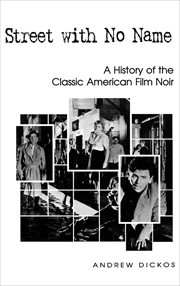Nonfiction
eBook
Details
PUBLISHED
Made available through hoopla
DESCRIPTION
1 online resource
ISBN/ISSN
LANGUAGE
NOTES
A Choice Outstanding Academic Title Flourishing in the United States during the 1940s and 50s, the bleak, violent genre of filmmaking known as film noir reflected the attitudes of writers and auteur directors influenced by the events of the turbulent mid-twentieth century. Films such as Force of Evil, Night and the City, Double Indemnity, Laura, The Big Heat, The Killers, Kiss Me Deadly and, more recently, Chinatown and The Grifters are indelibly American. Yet the sources of this genre were found in Germany and France and imported to Hollywood by emigré filmmakers, who developed them and allowed a vibrant genre to flourish. Andrew Dickos's Street with No Name traces the film noir genre back to its roots in German Expressionist cinema and the French cinema of the interwar years. Dickos describes the development of the film noir in America from 1941 through the 1970s and examines how this development expresses a modern cinema. Dickos examines notable directors such as Orson Welles, Fritz Lang, John Huston, Nicholas Ray, Robert Aldrich, Samuel Fuller, Otto Preminger, Robert Siodmak, Abraham Polonsky, Jules Dassin, Anthony Mann and others. He also charts the genre's influence on such celebrated postwar French filmmakers as Jean-Pierre Melville, François Truffaut, and Jean-Luc Godard. Addressing the aesthetic, cultural, political, and social concerns depicted in the genre, Street with No Name demonstrates how the film noir generates a highly expressive, raw, and violent mood as it exposes the ambiguities of modern postwar society
Mode of access: World Wide Web







